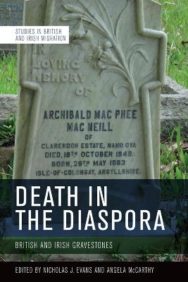
ABOUT THIS BOOK
PUBLISHER: Edinburgh University Press
FORMAT: Hardback
ISBN: 9781474473781
RRP: £75.00
PAGES: 256
PUBLICATION DATE:
October 31, 2020
BUY THIS BOOK
As an Amazon Associate and Bookshop.org affiliate we earn from qualifying purchases.
Death in the Diaspora: Gravestones and Memorial Markers Across the British World
Nicholas Evans
Angela McCarthy
A pioneering comparative study of migrant death markers across the British and Irish worlds and what they can tell us about notions of ‘home’Sets out an innovative agenda for comparative analysis of death markers in different parts of the formal and informal British EmpireProvides analyses based on hundreds of thousands of gravestones and memorial markers in the UK and Ireland, Australasia, Asia, Africa and the AmericasInvestigates the effects of religious identities in death and how they differ between memorials in Britain and IrelandAs British and Irish migrants sought new lives in the Caribbean, Asia, North America and Australasia, they left a trail of physical remains where settlement occurred. Between the 17th and 20th centuries, gravestones and elaborate epitaphs documented identity and attachment to their old and new worlds. This book expands upon earlier examination of cultural imperialism to reveal how individuals, kinship groups and occupational connections identified with place and space over time.With analyses based on gravestones and memorial markers in the UK and Ireland, Australasia, Asia, Africa and the Americas, the contributors explore how this evidence can inform 21st-century ideas about the attachments that British and Irish migrants had to ‘home’ – in both life and death.The book explores aspects of sociolinguistic difference evident in death markers and offers some insights into how growing literacy amongst migrant communities shaped the form of grave epitaphs. It expands upon earlier analyses of cultural imperialism to see how individual families and kinship groups identified with place and space over time and discusses how post-medieval archaeology from a range of death landscapes highlight difference rather than uniformity – including influences by Dutch, Jewish, Muslim and non-religious norms upon memorialisation practices.It also reveals how women and children, often marginalised voices in imperial scholarship, were as likely to be provided with more elaborate death markers than their male counterparts and challenges ideas of chain migration by demonstrating that families often moved to different, rather than similar, destinations overseas









